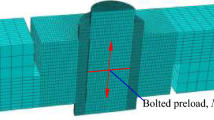Abstract
The dynamic forces which occur in structures whose jointed parts may slide during dynamic loading are associated with energy dissipation. The high-strength friction grip bolted joint (HSFGBJ) is a structural element which under certain circumstances may dissipate a large amount of vibrational energy. This energy is an increasing function of the frictional force and of the magnitude of slip of the joint. However, in a joint with a relatively large number of bolts, the amount of slip cannot be large, as the bolt holes are not much larger than the bolt diameter. Thus, some bolts of the joint may be sheared at the beginning of the full-slip stage of loading. In this paper, mathematical equations for the frictional force and slip in both stages of loading—partial slip and full slip—are established, and the dissipation of energy is evaluated. It is shown that if the joint is designed so that the magnitude of slip is at the border partial slip/full slip, the joint may dissipate a large amount of vibrational energy.
Similar content being viewed by others
References
Andrew, C., Cockburn, J.A. andWaring, A.E., “Metal Surfaces in Contact Under Normal Forces-Some Dynamic Stiffness and Damping Characteristics,”Proc. Inst. of Mech. Eng.,182,Pt. 3K,92–100 (1968).
Robers, P.F. and Boothroyd, G., “Damping at Metallic Interfaces Subjected to Oscillating Tangential Load,” Trans. ASME, Paper 74-WA/Prod 9 (1974).
Groper, M. and Hemmye, J., “The Dissipation of Energy in High Strength Friction Grip Bolted Joints,” Proc. 1983 SESA Spring Conf., Cleveland, OH (1983).
Tajima, J., “Effects of Relaxation and Creep on the Slip Load of the High-Strength Bolted Joints,”Structural Design Office, Japanese National Railways, Tokyo (1964).
Groper, M., Bausic, V. andd'Albon, G., “Measuring and Control Method for the Prestressing Force and Its Variation in Time of High Tensile Bolts,”Studii si Cercetari, Seria Const. Metalice (7),1NCRC, Bucuresti, Romania (1966).
Chesson, E. Jr. and Munse, W.H., Studies of the Behavior of High-Strength Bolts and Bolted Joints, Univ. of Illinois, Eng. Exper. Station, Bul. 469 (1964).
Vasarhelyi, D.D. andChiang, K.C., “Coefficient of Friction in Joints of Various Steels,”J Struc. Div., ASCE,93 (ST4),227 (1967).
Groper, M. and Hemmye, J., “Partial Slip Damping in High Strength Friction Grip Bolted Joints,” Proc. Fourth Int. Conf. on Mathematical Modeling, Pergamon Press (Aug. 1983).
Ludema, K., Handbook of Lubrication,II—Theory and Design, Part I—Friction, CRC Press Inc. (1983).
Bickford, H.J., An Introduction to the Design and Behavior of Bolted Joints, Marcel Dekker Inc., New York and Basel (1981).
Gould, H.H. and Mikic, B.B., “Areas of Contact and Pressure Distribution in Bolted Joints,” Trans. ASME,94 (3), (Aug. 1972).
Jacobsen, L.S., “Damping in Composite Structures,” Proc. 2nd WCEE, Tokyo, Japan,2 (1960).
Jennings, P.C., “Equivalent Viscous Damping for Yielding Structures,” J. Eng. Mech. Div., ASCE,94 (EMI, A.M.), (1968).
Author information
Authors and Affiliations
Rights and permissions
About this article
Cite this article
Groper, M. Microslip and macroslip in bolted joints. Experimental Mechanics 25, 171–174 (1985). https://doi.org/10.1007/BF02328808
Received:
Revised:
Issue Date:
DOI: https://doi.org/10.1007/BF02328808



